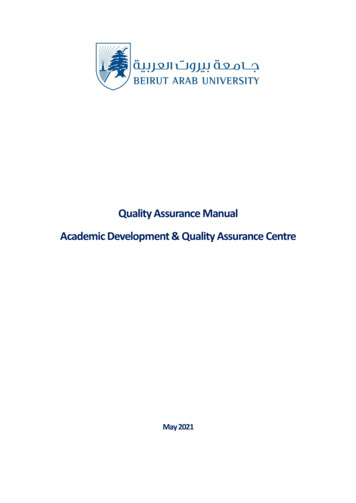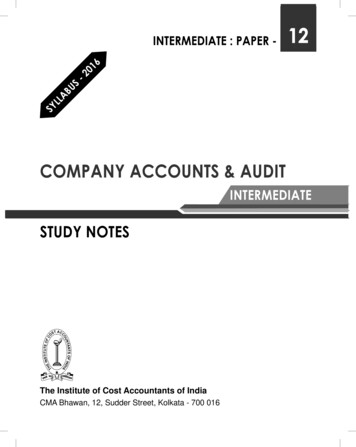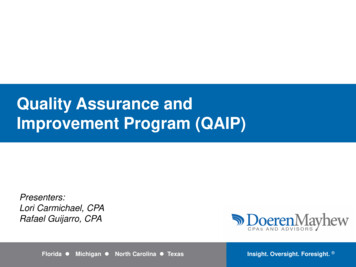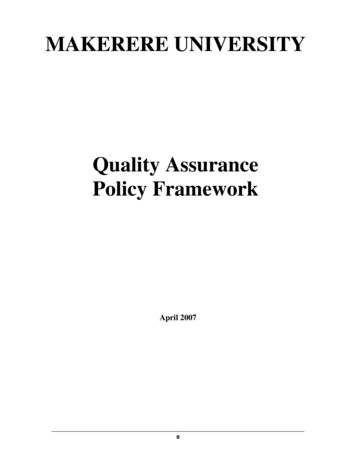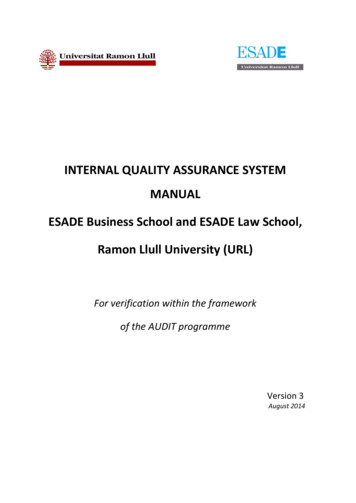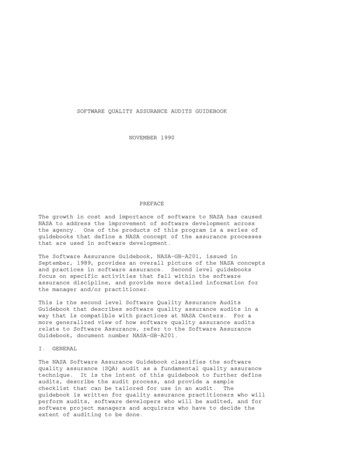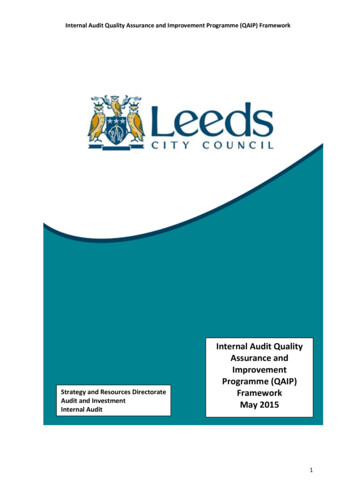
Transcription
Internal Audit Quality Assurance and Improvement Programme (QAIP) FrameworkStrategy and Resources DirectorateAudit and InvestmentInternal AuditInternal Audit QualityAssurance andImprovementProgramme (QAIP)FrameworkMay 20151
Internal Audit Quality Assurance and Improvement Programme (QAIP) ion andInternal Assessment- On-going quality assurance arrangements- Periodic ReviewsExternal AssessmentReporting on Quality Assurance and Improvement Programme2
Internal Audit Quality Assurance and Improvement Programme (QAIP) Framework1.Introduction and Background1.1The Public Sector Internal Audit Standards (PSIAS) came into force from 1st April2013. The standards apply the Institute of Internal Auditors’ (IIA) InternationalStandards to the UK public sector.1.2Attribute standard 1300 - Quality Assurance and Improvement Programme (QAIP)states that: ‘The Chief Audit Executive must develop and maintain a quality assuranceand improvement programme that covers all aspects of the internal audit activity.’1.3The QAIP is designed to enable an evaluation of the internal audit activity’sconformance with the Definition of Internal Auditing and the Standards and anevaluation of whether internal auditors apply the Code of Ethics. The programmealso assesses the efficiency and effectiveness of the internal audit activity andidentifies opportunities for improvement.1.4The QAIP must include both internal and external assessments.1.5Internal assessments must include: 1.6On-going monitoring of the performance of the internal audit activity. This isan integral part of the day-to-day supervision, review and measurement ofthe internal audit activity. On-going monitoring is incorporated into theroutine policies and practices used to manage the internal audit activity anduses processes, tools and information considered necessary to evaluateconformance with the Definition of Internal Auditing, the Code of Ethics andthe Standards; andPeriodic self-assessments or assessments by other persons within theorganisation with sufficient knowledge of internal audit practices. Periodicassessments are conducted to evaluate conformance with the Definition ofInternal Auditing, the Code of Ethics and the Standards.External assessments must be undertaken at least once every five years by aqualified, independent assessor or assessment team from outside the organisationand may be either a full external assessment or a self-assessment with independentvalidation. The standards require the Head of Internal Audit1 to discuss with theBoard (within Leeds City Council the Corporate Governance and Audit Committee): The form of external assessments;1Within Leeds City Council the role of ‘Chief Audit Executive’ as defined by the PSIAS is fulfilled by the Head ofInternal Audit.3
Internal Audit Quality Assurance and Improvement Programme (QAIP) Framework The qualifications and independence of the external assessor or assessmentteam, including any potential conflict of interest.1.7Within Leeds City Council, the Head of Internal Audit is responsible for the QAIP,which covers all types of Internal Audit activities. Under the QAIP, quality should beassessed at both an individual audit engagement (assignment) level as well as at abroader internal audit activity level (i.e. covering the internal audit serviceprovision.)1.8All staff within Internal Audit have responsibility for maintaining quality. Theactivities outlined in this QAIP involve all staff.1.9Internal Audit’s QAIP is designed to provide reasonable assurance to the variousstakeholders of Leeds City Council Internal Audit Service that Internal Audit: 1.10Performs its work in accordance with its Charter, which is consistent with thePublic Sector Internal Audit Standards, Definition of Internal Auditing andCode of Ethics;Operates in an efficient and effective manner;Is adding value and continually improving its operations.Internal Audit’s QAIP will therefore cover all aspects of the Internal Audit activity. Inthis regard, a list of the features to be considered for the QAIP: Monitors the Internal Audit activity to ensure it operates in an effective andefficient manner (Attribute Standard 1300.)Assures compliance with the Standards, Definition of Internal Auditing andCode of Ethics (Attribute Standard 1300.)Helps the Internal Audit activity add value and improve organisationaloperations (Attribute Standard 1300.)Includes both periodic and on-going internal assessments (Attribute Standard1311.)Includes an external assessment at least once every five years, the results ofwhich are communicated to the Board (Attribute standards 1312, 1320.)4
Internal Audit Quality Assurance and Improvement Programme (QAIP) FrameworkSource: IIA International Professional Practice Framework (IPPF) Practice Guide - Quality Assurance andImprovement Program2.Internal AssessmentInternal Assessment is made up of both on-going reviews and periodic reviews:2.1On-going quality assurance arrangements2.1.1 Leeds City Council Internal Audit maintains appropriate on-going quality assurancearrangements designed to ensure that internal audit work is undertaken inaccordance with relevant professional standards (specifically the PSIAS).These arrangements include:2.1.2 Internal Audit Assignment Level The maintenance of a detailed audit procedures manual and qualitymanagement system to ensure compliance with applicable planning, fieldworkand reporting standards. The objectives, scope and expected timescales for each audit assignment subjectto agreement with the client before detailed work commences;5
Internal Audit Quality Assurance and Improvement Programme (QAIP) Framework The results of all audit testing work documented using the standard workingpapers; Documented review of file/working papers by an Audit Manager/Senior AuditManager/Principal Audit Manager and sign-off of each stage of the audit processto ensure that:- All work undertaken complies with the requirements ofprofessional best practice and appropriate audit techniques havebeen used;- Audit files are complete and properly structured;- The objectives of the audit have been achieved;- Appropriate levels of testing have been carried out;- The findings and conclusions are sound and are demonstrablysupported by relevant, reliable and sufficient audit evidence- The final audit report is complete, accurate, objective, clear,concise, constructive and timely. Supervision of audit engagements; Regular 1:2:1 meetings to monitor progress with audit assignments; Audits with Limited/No Assurance are reviewed by the Head of Internal Auditwith the team carrying out the assignment; Customer satisfaction questionnaires are issued with each final audit report toobtain feedback on the performance of the auditor and on how the audit wasreceived. The questionnaire consists of 12 questions which require grading from1 to 5 where 1 is poor and 5 is excellent; Post Audit Assessment forms completed after each audit assignment to evaluateperformance against CIPFA’s Excellent Internal Auditor (originally developed byLCC Internal Audit) competency framework including performance managementand identify any training and development requirements as well asacknowledging any areas of excellent performance; Final reports and recommendations are reviewed and approved by the PrincipalAudit Manager or the Head of Internal Audit.The results of the on-going quality assurance arrangements at an assignment levelwill be reported in the regular update reports and annual report to CorporateGovernance and Audit Committee. These include the results of customer satisfactionquestionnaires and the results of the bi-annual external assessment of the section’squality procedures.6
Internal Audit Quality Assurance and Improvement Programme (QAIP) FrameworkInternal Audit Activity Level The Internal Audit annual plan is produced using a risk based approach asdocumented in the Internal Audit annual plan methodology: The Section’s quality management system has accreditation to quality standardISO 9001:2008 with UKAS. This is reviewed by an external body (SGS) bi-annually; The Internal Audit technical manual provides a detailed description of the workof the internal audit service and the way in which work should be carried out.This is a point of reference for staff and guides them through the relevantstandards the procedures followed within Internal Audit; The Internal Audit Charter provides stakeholders with a formally definedpurpose, authority and responsibility of the Internal Audit activity as well asformalising the Code of Ethics for members of the Internal Audit team; Continuous development of the internal audit team to ensure it possesses thenecessary capacity, skills and knowledge to successfully deliver the annual auditplan including:- Job descriptions and detailed competency profiles for eachinternal audit post;Regular performance appraisals with individual developmentplans;Training strategy and associated training activities withdocumented training records;Active encouragement of Continuing Professional Development(CPD) within the Section. In addition as the majority of staff areprofessionally qualified/training, there is a personal requirementto undertake CPD on an on-going basis;Performance against agreed quality targets reported to Corporate Governanceand Audit Committee on a regular basis.Results of the on-going assessments at activity level will be included in theInternal Audit annual report.2.1.3 Activity reporting to Corporate Governance and Audit CommitteeOn a regular basis (in accordance with the Committee’s agreed work programme),Internal Audit provides the Corporate Governance and Audit Committee with an7
Internal Audit Quality Assurance and Improvement Programme (QAIP) Frameworkupdate report summarising the audit activity undertaken during the period. Thisincludes the following:2.2 Progress against the annual plan in terms of audit days achieved; A list of reports issued during the period including details of the opinionprovided - assurance provided for the control environment and compliancewith the control environment; and the organisational impact. All reports witha major organisation impact are reported to Corporate Leadership Team; A summary of the key issues and outcomes from the work undertaken in theperiod including findings from any reviews reported during the period withlimited or no assurance; Customer satisfaction results from questionnaires received with anycorrective action identified.Periodic Reviews2.2.1 Periodic assessments are designed to assess conformance with Internal Audit’sCharter, the Standards, Definition of Internal Auditing, the Code of Ethics, and theefficiency and effectiveness of internal audit in meeting the needs of its variousstakeholders. Periodic assessments are conducted through: Audits of the Section’s Quality Management System are undertaken on ascheduled basis for performance in accordance with Internal Audit’s QualityProcedures Manual (usually twice a year) by an external assessor (SGS.) SGSprovide a conclusion on whether LCC Internal Audit has established andmaintained its management system in line with the requirements of thestandard and demonstrated that ability of the system to systematicallyachieve agreed requirements for products or services within the scope andthe organisation’s policy and objectives; Regular reviews to confirm compliance with Information Governancerequirements; Regular activity and performance reporting to the Corporate Governance andAudit Committee (through their agreed work programme) and Section 151officer; Annual self-review of conformance with the Public Sector Internal AuditStandards. This will be done using CIPFA’s ‘Checklist for assessing compliance8
Internal Audit Quality Assurance and Improvement Programme (QAIP) Frameworkwith PSIAS and the Local Government Application Note’ which was developedto satisfy the requirements set out in PSIAS 1311 and 1312 for periodic selfassessments and externally validated self-assessments as part of the QualityAssurance and Improvement Programme. Annual customer survey.Any resultant action plans will be monitored by Head of Audit on a regular basis.Annual self-assessment reviews2.2.2 On an annual basis, the Head of Internal Audit will update the Public Sector InternalAudit Standards (PSIAS) self-assessment checklist and obtain evidence todemonstrate conformance with the standards.2.2.3 The results of the PSIAS self-assessment are used to identify any areas requiringfurther development and/or improvement. Any specific changes or improvementsare included in the annual Improvement Action Plan. Specific actions may also beincluded in the Financial Services Service Plan for Internal Audit and/or individualpersonal development action plans.2.2.4 The results will also be used to evaluate overall conformance with the PSIAS, theresults of which are reported to the senior management and the CorporateGovernance and Audit Committee as part of the annual report of the Head ofInternal Audit.3.External assessment3.1At least once every five years, internal audit working practices are subject to externalassessment to ensure the continued application of professional standards. Thisprocess will appraise and express an opinion about internal audit’s conformancewith the Standards, Definition of Internal Auditing and Code of Ethics and includerecommendations for improvement, as appropriate.3.2The assessment is conducted by an independent and suitably qualified person ororganisation and the results are reported to the Head of Internal Audit.3.3Results of external assessments will be reported to the Corporate Governance andAudit Committee and Section 151 Officer at the earliest opportunity followingreceipt of the external assessors report. The external assessment report will beaccompanied by a written action plan in response to significant findings andrecommendations contained in the report. Any specific areas identified as requiring9
Internal Audit Quality Assurance and Improvement Programme (QAIP) Frameworkfurther development and/or improvement will be included in the annualImprovement Action Plan for that year.3.44.The external assessment process will consist of a broad scope of coverage thatshould include – as a minimum - the following elements of Internal Audit activity: Conformance with the Standards, Definition of Internal Auditing, the Code ofEthics, and Internal Audit’s Charter, procedures, plans, practices and anyapplicable legislative and regulatory requirements; Expectations of Internal Audit as expressed by senior management andoperational management; Tools and techniques used by Internal Audit; The mix of knowledge, experiences and disciplines within the team. Whether Internal Audit adds value and improves the organisation’soperations.Reporting on Quality and Improvement ProgrammeInternal Assessments4.1.1 Results of internal assessments will be reported to the Corporate Governance andAudit Committee and to senior management at least annually. The results of theQAIP and progress against any improvement plans will be included in the annualInternal Audit report.External Assessments4.2Results of external assessments will be provided to senior management and theCorporate Governance and Audit Committee. The external assessment report will beaccompanied by an action plan in response to recommendations made in the report.Follow Up4.3The Head of Internal Audit will implement appropriate follow up actions to ensurethat recommendations made in the report and action plans developed areimplemented in a reasonable timeframe.10
broader internal audit activity level (i.e. covering the internal audit service provision.) 1.8 All staff within Internal Audit have responsibility for maintaining quality. The activities outlined in this QAIP involve all staff. 1.9 Internal Audit's QAIP is designed to provide reasonable assurance to the various

